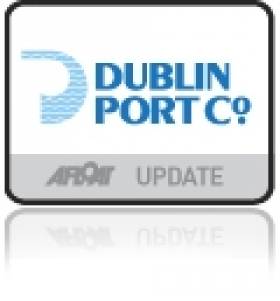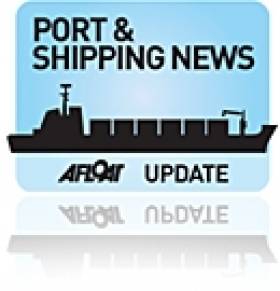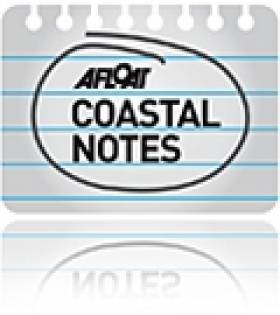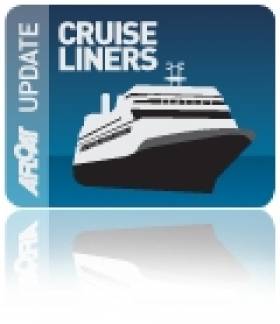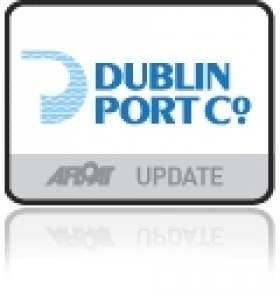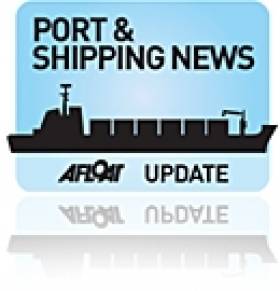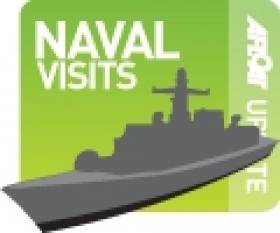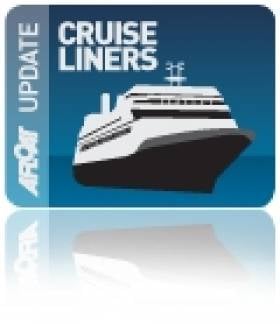Displaying items by tag: Port of Dublin
This weekend sees ancient gaff-rigged and other craft of multiple vintages gathering at Poolbeg Yacht and Boat Club in Ringsend in the heart of Dublin Port, within sight of some of the most modern ships afloat. It’s the 60th Anniversary of the Old Gaffers Association, and the fact that Dublin is central to the OGA’s Diamond Jubilee Cruise-in-Company speaks volumes for the welcome the port provided for the Golden Jubilee Cruise in 2013, when it became clear that owners of vintage or classical Bermudan-rigged boats were also welcome. It seems that being part of the community is a matter of the right attitude rather than undue fussiness about exactitude of rig.
Yet it’s a curiosity of international sailing history that in 1963 the definitive gaff-rigged One Designs of Dun Laoghaire - the 1902-originating Dublin Bay 21s - were in the process of changing to Bermuda rig. For at the same time, separate meetings in the south and southeast of England were - unbeknownst to each other – laying the foundations for the beginnings of the Old Gaffers Association for the preservation of gaff-rigged sailing skills.
THE MAN FROM THE ELEPHANT BOATYARD
As one of the main movers in the initial south coast meeting in Winchester was Mike Richardson of the renowned and distinctly characterful Elephant Boatyard on the upper reaches of the Hamble River, it’s not surprising that over the years, it was recognised that a contemporary meeting at Maldon in Essex was where the Old Gaffers Association really came into being.
 The rapid development of the OGA on England’s East Coast soon meant there was a keen Dutch branch, and they were present in strength in Dublin Bay in 2013, with the steel-built Cinne Mara (based on the design of a Galway hooker) seen here chasing fellow Dutch boat Raven, built to a Lyle Hess design. Photo: W M Nixon
The rapid development of the OGA on England’s East Coast soon meant there was a keen Dutch branch, and they were present in strength in Dublin Bay in 2013, with the steel-built Cinne Mara (based on the design of a Galway hooker) seen here chasing fellow Dutch boat Raven, built to a Lyle Hess design. Photo: W M Nixon
For they could focus on moving things forward in a single-minded way, whereas Mike of the Elephant and his friends – unaware of any developments on the East Coast – had so many boat interests on the go at the same time that the progressing of an idea for a new association had to take its place in the queue. For sure, they did eventually run a couple of races for old gaffers in the Solent. But once they realized that things had been happening in a more clear-cut form on the East Coast, the two groupings became one with the East Coast setting the pace.
INTERNATIONAL LINKS
Soon they were drawing in fellow enthusiasts, both countrywide and with international links. Success was such that by the time the Golden Jubilee came around in 2013, they had the strength and enthusiasm to organise a well-supported Round Britain Rally with many interesting ports visited, and with two stops on Ireland’s East Coast - at Poolbeg in Dublin, and in Belfast Port in Northern Ireland hosted by the NIOGA.
 Legends of the sea. Dickie Gomes, first winner in 2013 of the Leinster Plate with the 101-year-old Ringsend-built Ainmara, with Tim Magennis, President at the time of the hosting Dublin Bay Old Gaffers Association, and himself a veteran of a round the world voyage in the gaff-rigged Colin Archer ketch Sandefjord. Photo: W M Nixon
Legends of the sea. Dickie Gomes, first winner in 2013 of the Leinster Plate with the 101-year-old Ringsend-built Ainmara, with Tim Magennis, President at the time of the hosting Dublin Bay Old Gaffers Association, and himself a veteran of a round the world voyage in the gaff-rigged Colin Archer ketch Sandefjord. Photo: W M Nixon
The Irish stopovers were extensively covered on Afloat.ie with special enthusiasm, as your columnist happened to be sailing throughout all the happenings on the Irish coast with Dickie Gomes of Strangford Lough aboard the Ringsend-built 9-ton J B Kearney yawl Ainmara. And our enjoyment was in no way lessened by winning the inaugural race for the Leinster Trophy in Dublin Bay, with the trophy being handed over about 200 yards from where Ainmara had been born 101 years earlier.
 Even ten years ago, Bermudan rigged vintage boats were welcomed as OGA members, and here Ainmara is leading the inaugural race for the Leinster Plate in Dublin Bay at the OGA Golden Jubilee in 2013. Photo: Dave Owens
Even ten years ago, Bermudan rigged vintage boats were welcomed as OGA members, and here Ainmara is leading the inaugural race for the Leinster Plate in Dublin Bay at the OGA Golden Jubilee in 2013. Photo: Dave Owens
TWO IRISH BRANCHES HAVE BECOME ONE FOR ALL
Since then, the two Irish branches of the OGA have become one, with the DBOGA in effect covering the whole country, as the President is Adrian “Stu” Spence whose 47ft ketch El Paradiso is based in Ringhaddy Sound in Strangford Lough, while the Honorary Secretary Darryl Hughes now lives in Crosshaven, where he bases his 43ft gaff ketch Maybird, designed by Fred Shepherd and built by Jack Tyrrell of Arklow in 1937.
This national spread is further emphasized by former international OGA President Sean Walsh – in 2013, he was Dun Laoghaire-based with his Heard 28 gaff cutter Turn a nOg – now being a Kinsale sailor. He and Darryl Hughes have combined forces to sail Tir na nOg east and north to Ringsend to help co-ordinate the Poolbeg events, which are under the overall direction of Adrian Spence and former PY&BC Commodore Johnny Wedick.
 Local boats join the international fleet – Sean Walsh’s Tir na nOg from Dun Laoghaire dicing in Dublin Bay with Paul Holden’s Peapod from Howth. Photo: Dave Owens
Local boats join the international fleet – Sean Walsh’s Tir na nOg from Dun Laoghaire dicing in Dublin Bay with Paul Holden’s Peapod from Howth. Photo: Dave Owens
The friendly atmosphere in Poolbeg Y & BC lends itself well to mutlti-generational events of this type, an excellent example being the recent launching of marine and civic historian Cormac Lowth’s fascinating book about the Ringsend sailing trawlers. The Ringsend fishery began to be of major significance when the Brixham fishermen from Devon started expanding their operations after the ending of the Napoleonic Wars around 1818. And they succeeded so well in their new Ringsend base that by the 1880s the renowned Murphy family in Ringsend built and very successfully fished the largest Brixham-type fishing boat ever, the legendary St Patrick.
 So successful were the Ringsend fishermen in adopting and developing the technology brought to them by their immigrants from Brixham that the largest fishing boat built to the Brixham trawler concept was the famous St Patrick – designed, built and fished by the Murphy family of Ringsend. Photo: Courtesy Cormac Lowth
So successful were the Ringsend fishermen in adopting and developing the technology brought to them by their immigrants from Brixham that the largest fishing boat built to the Brixham trawler concept was the famous St Patrick – designed, built and fished by the Murphy family of Ringsend. Photo: Courtesy Cormac Lowth
RAYTOWN
Modern developments on the Ringsend waterfront mean that it is now difficult to imagine this area as a thriving fishery services foreshore, but such was very much the case. And the visit of a group such as the Old Gaffers is a timely occasion to reflect on the period when this was known to Dubliners as Raytown. The local fishing community kept the despised ray for their own consumption while selling the more profitable sought-after species. Consequently it was observed that you could find Ringsend in fog or total darkness relying only on the all-pervading smell of ray being wind-dried on lines for preservation for winter consumption.
THE DUN LAOGHAIRE WAY
Needless to say the arrival of the idea of local Old Gaffers Associations in Ireland was greeted with mixed feelings. It’s doubtful if those such as Cass Smullen, who were arguing to keep the DB21s gaff-rigged, would have been known that at the same time two separate groups in England were thinking in the same general way. Or if he did, then he would have been well aware that support from that quarter might not have helped his cause at all, as Dun Laoghaire has always liked its own way of doing things.
 The Dublin Bay 21 Geraldine arrives back in Dun Laoghaire on Wednesday of this week, after being re-born under the skills of Steve Morris of Kilrush Boatyard. Photo: DB21
The Dublin Bay 21 Geraldine arrives back in Dun Laoghaire on Wednesday of this week, after being re-born under the skills of Steve Morris of Kilrush Boatyard. Photo: DB21
 The restored DB21 Garavogue, setting her new “American gunter” rig, winning the last race of the 2022 season. The Dublin Bay 21s had decided to change to Bermudan rig in 1963 just as the Old Gaffers Association came into being to preserve gaff rig and the skills needed to use it.
The restored DB21 Garavogue, setting her new “American gunter” rig, winning the last race of the 2022 season. The Dublin Bay 21s had decided to change to Bermudan rig in 1963 just as the Old Gaffers Association came into being to preserve gaff rig and the skills needed to use it.
For despite the interest in Bermuda rig, the fact is we were up to our tonsils in gaff rigged boats, and still are. But they are mainly used very actively for racing, such that boats like the Dublin Bay Water Wags and the Howth 17s don’t see themselves as Old Gaffers at all - on the contrary, their self-image is of a hot racing class which just happens to be gaff rigged.
ENGLISH CULTURAL IMPERIALISM?
This relaxed acceptance of gaff rig as being very much alive and a natural part of the contemporary Irish sailing scene was brought home to me many years ago when an English gaff-rigged enthusiast called Alan Hidden arrived to work in Northern Ireland, and although a decent enough person, he carried the usual baggage of English cultural imperialism in some maritime matters.
 One of the most interesting boats due in Poolbeg is the former Bristol Channel Pilot Cutter Letty of 1905 vintage. But don’t assume that her impressive presence will be a subtle case of English maritime cultural imperialism. Her owner-skipper Steve Cogdell proudly flies the Cornish ensign, which suggests that he and his crew see themselves as being completely independent of just about everyone else on the planet. Photo: Patrick Vyvyan-Robinson
One of the most interesting boats due in Poolbeg is the former Bristol Channel Pilot Cutter Letty of 1905 vintage. But don’t assume that her impressive presence will be a subtle case of English maritime cultural imperialism. Her owner-skipper Steve Cogdell proudly flies the Cornish ensign, which suggests that he and his crew see themselves as being completely independent of just about everyone else on the planet. Photo: Patrick Vyvyan-Robinson
For very soon, we had a letter from him to Afloat Magazine saying that he had discovered a marvellous old clinker-built gunter-rigged 14ft sailing dinghy called Mantis which once upon a time had belonged to a “long extinct” class called the Ballyholme Insects, and his plan was to restore her and use her as the foundation on which to build a Northern Ireland branch of the Old Gaffers Association.
THE PICKLE FORK CLUB
“Mixed feelings” barely begins to describe the reaction in the luxuriously-appointed editorial offices of Afloat Verbiage Industries plc.. For once upon a time, we owned, sailed, raced, cruised and did many others things of a rites-of-passage and highly educational nature with an Insect. Thus the thought that somebody should see them as quaint Old Gaffers was appalling.
Worse still was kitting an Insect with tan sails sporting an OGA number and the Old Gaffer symbol. It’s supposed to be based on a set of classic gaff boom jaws, but a totally Bermuda-rigged shipmate always refers to the OGA as “The Pickle Fork Club”, and on this evidence of English cultural imperialism as applied to a Ballyholme Insect, I was inclined to agree with him.
 Sacrilege! The Ballyholme Insect Class Mantis being re-purposed as a propaganda tool for the Old Gaffers Association, showing clearly why sniffy Bermuda-rig enthusiasts refer to the OGA as “The Pickle-Fork Club”. This photo of Mantis was taken at the very tidal inlet of Dundrum on the County Down coast, where Regatta Day is selected so that at low water ponies can conveniently be raced around the same course that sailing craft use at high water.
Sacrilege! The Ballyholme Insect Class Mantis being re-purposed as a propaganda tool for the Old Gaffers Association, showing clearly why sniffy Bermuda-rig enthusiasts refer to the OGA as “The Pickle-Fork Club”. This photo of Mantis was taken at the very tidal inlet of Dundrum on the County Down coast, where Regatta Day is selected so that at low water ponies can conveniently be raced around the same course that sailing craft use at high water.
THE DBOGA ARE OKAY
Until, that is, I found that the Dublin Bay Branch of the Old Gaffers Association included such solidly maritime souls as Tim Magennis and Johnny Wedick and Denis Aylmer and the merry band with Paul Keogh on the Clondalkin-built Galway hooker Naomh Cronan and many others.
So we threw ourselves with enthusiasm into the DBOGA’s prominent role in the Golden Jubilee Celebrations in 2013, albeit with the Bermudan-rigged Ainmara. But then, her antique Ringsend associations probably gave her more right to be there than any other boat in the fleet.
 Solid sailing citizen. DBOGA pioneer Dennis Aylmer of Dun Laoghaire may sail the “plastic fantastic” Mona these days, but back in the 1960s he was one of the key enthusiasts for Galway Hookers in Dublin Bay.
Solid sailing citizen. DBOGA pioneer Dennis Aylmer of Dun Laoghaire may sail the “plastic fantastic” Mona these days, but back in the 1960s he was one of the key enthusiasts for Galway Hookers in Dublin Bay.
Yet now with the Diamond Jubilee upon us, it’s disconcerting to find how much has changed in just ten years, which you’d think in Old Gaffer terms is just the twinkling of an eye. Ainmara has been sold to Swiss owners, Adrian Spence’s 1873-built Madcap has been sold to France, Joe Pennington’s Master Frank, the pride of the Isle of Man, is very much on the market, and now the Naomh Cronan is based in Galway.
THE GOOD NEWS
Yet the news is not all one way. On the upside, Hal Sisk and Fionan de Barra of Dun Laoghaire are more than halfway towards the restoration of the Dublin Bay 21 Class, with the arrival in Dun Laoghaire this week of the newly-restored Geraldine from the skilled hands of Steve Morris and his team in Kilrush.
 Current DBOGA President Adrian Spence (right) absorbing wisdom (and much else) with old salts Joe Pennington (left) and Dickie Gomes. Photo: W M Nixon
Current DBOGA President Adrian Spence (right) absorbing wisdom (and much else) with old salts Joe Pennington (left) and Dickie Gomes. Photo: W M Nixon
And in Strangford Lough, the classic Manx nobby White Heather has returned, complete with her authentic widow-maker of a dipping lug rig, brought back to her longtime home by Gary Lyons who apparently more or less did a straight swap with his vintage Bermuda ketch Ocean Dove with previous White Heather owner Mike Clarke of Peel.
And as for this weekend at Poolbeg, the fact that all places were booked out within a few days of bookings becoming available tells us that the OGA – and Poolbeg Yacht & Boat Club with it - are in good health.
 Summer’s evening at Poolbeg in Dublin Port during the 2013 visit of the Old Gaffers Association. Photo: W M Nixon
Summer’s evening at Poolbeg in Dublin Port during the 2013 visit of the Old Gaffers Association. Photo: W M Nixon
Former Dundalk Dredger Sold in Dublin Port
#DUBLIN PORT-The former Dundalk Port Company grab-hopper dredger Hebble Sand (1963/757grt), which has been laid-up in Dublin since last Summer, was sold to new owners a month ago, writes Jehan Ashmore.
She remains berthed at the Bulk Jetty, Alexandra Basin, where she arrived from the Co. Louth port on 14 July, two days after the assets, liabilities and operations of Dundalk Port Company were transferred to Dublin Port Company by an order of statutory instrument. Against this background, Dublin Port Company decided to divest in the business of dredging resulting in placing the veteran vessel for sale.
During her career in Drogheda, she was the only dredger to be operated and owned by a port company apart from the suction-trailer dredger Lough Foyle (1979/868grt) operated by Londonderry Port & Harbour Commissioners.
Hebble Sand, registered in Dundalk has retained her original name since her launch from Richard (Shipbuilders) of Lowestoft for British Dredging. She has been kept in good condition considering a career nearing five decades. To read some of her last contracts undetaken outside her homeport, click HERE.
From a distance some people have mistaken Hebble Sand (PHOTO) to the last of the 'Guinness ships, as she bores a resemblance to the final custom-built stout tanker Miranda Guinness ( PHOTO), taken on her farewell sailing. The vessels shared a similar red funnel and black funnel, a roomy sized superstructure painted in cream above and a dark blue hull. To read more about the last of the brewery tanker-fleet click HERE.
Lecture: 'Searching for Saints-Skelligs to Iceland'
#LECTURES-Paddy Barry will be presenting "Searching for Saints –Skelligs to Iceland" the second of five Winter talks in a programme organised by the Dublin Bay Old Gaffers Association (DBOGA). The talk takes place this Tuesday evening at 8pm in the Poolbeg Yacht and Boat Club, Ringsend in Dublin Port.
Those wishing to attend may wish to arrive a bit earlier so to avail of the PYBC's clubhouse facilities, which overlooks its marina in the centre of the port, opposite Alexandra Basin.
The venue is located on the South Bank, Pigeon House Road, Ringsend which can be accessed from the Sean Moore Road that connects the Merrion Strand Road (from the south) and the East-Link Toll Bridge (from the north).
For further information on the DBOGA lectures and more click HERE. In addition information about the PYBC Tel: (01) 668 9983 or logon to www.poolbegmarina.ie/
Giant New Car Truck Carrier Docks in Dublin
She is operated by Wallenius Wilhelmsen Lines (WWL) and was built by Daewoo Shipbuilding & Marine Engineering. The new vessel's principle dimensions are (length: 227.8m, beam: 32.26 and a draft of 11.3m) and she has a deadweight (metric tonnes) of 30,900.
The Swedish company together with subsidiaries and partner's, operates a fleet of about 135 vessels. Of these, Wallenius owns or charters around 35. They can carry up to 8,000 cars, or a combination of cars, trucks, cranes, large rolls of paper and rubber or large turbines. They have also transported parts for wind turbines, luxury yachts, complete train-sets and aircraft wings.
Figaro's docking in Dublin today was at berth 33, which is the centre berth of three lining Ocean Pier which has a quayside totalling 410m long. The pier is within Alexandra Basin and is to the east side of this dock which is approached from the port channel opposite the Poolbeg Marina.
After Dublin she continues her global schedule to Bremerhaven (16 Nov), Zeebrugge (23 Nov), Southampton (24 Nov), Baltimore, USA (3 Dec), Savannah, GA USA (6 Dec), Manzanillo, Panama (11 Dec), Auckland (29 Dec), Brisbane in the New Year (2 Jan) and two days later is expected to dock in Port Kemble also in Australia.
Earlier this year the world's largest ro-ro carrier Tonsberg (PHOTO) also part of the WWL fleet, docked in Dublin having entered service in March. She has a cargo volume of 138,000 cubic metres, some 10% greater than the largest ro-ro vessels in service including her fleetmate the Figaro.
The 74,622grt vessel is the first of four Mark V class on order from Mitsubishi Heavy Industries in Nagasaki, Japan. They are capable of handling handle high and heavy cargo such as excavators, bulldozers, wheel loaders and harvesters. Her sister Parsifal followed in September and the final pair of the quartet are due for delivery in 2012.
Tanker and Lifeboats Conduct Emergency Exercises off Dalkey Island
Crew kitted in similarly bright orange coloured sea safety-survival suits entered the lifeboat before it plunged into the water. The activity was observed through the binocular-scope which overlooks Coliemore Harbour with excellent views across the sound to Dalkey Island, Dublin Bay and Howth Peninsula.
The binocular-scope does not require payment to operate and was unveiled in 2008 in memory of local resident the late Dr. John de Courcy Ireland, the 'father' of maritime Ireland (to read more click HERE). He was for 26 years a honorary secretary of the local RNLI station in Dun Laoghaire and a staunch campaigner of Irish maritime affairs.
Each Monday a routine lifeboat practice is conducted by the 47ft Trent class ALB (all-weather lifeboat) RNLB Anna Livia (info and PHOTO). Last night's drill also involved the new D-class ILB (inshore lifeboat) RNLB Réalt na Mara which was named earlier this year by Kathy Kenny, wife of RTE presenter Pat Kenny.
Under the cover of darkness the crew of the ILB Realt na Mara simulated an 'injured casualty' on the island where the casualty was prepared to be taken off by stretcher from the island's small harbour. From there the casualty was transferred to the larger RNLB Anna Livia which lay offshore. During the exercise, powerful searchlight beams from the ALB provided essential light to assist in the transfer operation.
Asides the lifeboats, there is plenty of wildlife to observe on the rocky outcrops at Maiden Rock, Clare Rock and Lamb Island, which forms the second largest island after the main island of 22-acres, where a resident herd of goats have been part of the local community for over 200 years.
As for the South Korean built Cumbrian Fisher, she too has close connections with these waters as she was named in Dublin Port in 2005. She is a frequent caller to Dublin bringing bulk liquid products from the oil refinery in Milford Haven, Pembrokeshire which is a major supplier, serving the demands of the capital.
Dublin Port has two oil jetties which cater for four tankers, where bitumen, chemicals, liquid petroleum gases, molasses and oil are handled on a 41-hectare zone with storage for 330,000 product tonnes to include 6,000 tonnes of LPG. In addition aviation fuel is frequently delivered to the terminal to satisfy the constant demand for aircraft using Dublin Airport.
Cumbrian Fisher alongside her sister Clyde Fisher where built for James Fisher & Sons and in recent years they have tended to take anchorage off Dalkey Island and off the Nose of Howth. In comparison the vast majority of vessels anchor in Dublin Bay which is divided into quadrants for the purposes of anchorage allocation.
Before the completion of the South Wall in Dublin Port, which considerably improved safer access of vessels entering the River Liffey, it was the relative deeper and sheltered waters of Dalkey Sound which were used instead as Dalkey acted as the principle port for Dublin between 14-17th centuries.
Vessels would convey cargoes which were taken to and fro by lighter to the coast where it was carried by horse and cart to nearby Dalkey before onward travel across the exposed plains to Dublin City.
To learn more about Dalkey's medieval maritime heritage with its relationship with the capital of Dublin in addition the use of Dalkey Quarry in the construction of (Kingstown) Dun Laoghaire Harbour, visit the Dalkey Castle & Heritage Centre. To read more go to www.dalkeycastle.com in addition to further information about Dalkey including the local community council newsletters click HERE.
- Dublin Bay
- Dublin Airport
- Dublin Bay News
- Commissioners of Irish Lights
- Irish Lights
- coliemore harbour
- Pembrokeshire
- Dalkey Island
- Port of Dublin
- River Liffey
- Ports and Shipping News
- The Muglins
- Coastal Notes
- Howth Peninsula
- Pat Kenny
- Dalkey Sound
- Lighthouse news
- Irish Lighthouses
- Cumbrian Fisher
- Jas Fisher & Sons
- Clyde Fisher
- Milford Haven Oil Refinery
- Dalkey Castle & Heritage Centre
- Dr. Ireland
- Dr. John de Courcy Ireland
- Irish maritime historian
- Kingstown Harbour
- Kathy Kenny
- RTE presenter Pat Kenny
- South Wall Dublin Port
- Medieval Dalkey
- Dalkey Quarry
- Aviation fuel
- Dalkey Tidy Towns Committee
- Nose of Howth
- Dublin Port Oil Jetty Terminal
- Dalkey Community Council
- Dalkey Island Goats
Dublin Port Outlines Plans for First Dedicated Cruise Terminal
In order to facilitate this growth, the draft proposes switching existing berths used by large cruiseships away from unattractive cargo-docks in Alexandra Basin's West and East and at Ocean Pier. Up to three alternative locations were examined and the port agreed that the option identified in the Dublin City Council's Area Plan of the North Quay Extension is the optimum location.
Before any such development, it would require relocating an existing roll-on roll-off terminal (No.3), which is currently in use by P&O Irish Sea for their Dublin-Liverpool service. The company operate three sailings daily on the central corridor route.
The new facility could accommodate two large cruise ships simultaneously and would be much larger than the 43,524grt The World, the luxury resort vessel operated by Residensea, which docked at the North Wall Extension in 2010 (for report click HERE).
The location is on the doorstep to the East-Link Bridge and the neighbouring O2 Arena and Point Village developed by Harry Crosbie, who called for the relocation of cruise callers to be sited upriver.
According to the draft, the closer proximity to the city-centre would provide a stronger presence and a more accessible link with the city. It would also avoid the unnecessary longer bus transfers between cruise berths and visitor attractions in the city-centre and locations in counties Wicklow and Meath.
Construction of facilities for a cruise terminal would expensive as it will involve new quay walls capable of accepting large cruise vessels but this could only be done after dredging the channel to a depth of 10.5m.
The facilities of the terminal are to incorporate a reception, tourist information and interpretive centre, a dedicated entrance for pedestrians, coaches, vehicles and traffic management measures would be implemented.
In addition the site would also require the expensive exercise in re-locating ESB underwater high-voltage cables. The initial costs suggest to develop new terminal facilities and associated works would be in the region of €30m.
Dublin Port Company, state that due to the relatively low revenues generated by cruise ships, such an investment alone could not be justified, however, they could part-fund the development but additional funding would be required from other sources.
- Dublin Port
- Dublin Port Company
- The World
- Cruise Liners
- Harry Crosbie
- Port of Dublin
- Ports and Shipping News
- Point Village
- P&O (Irish Sea)
- Cruise Liner news
- Ocean Pier Dublin Port
- O2 Arena
- EastLink bridge
- Dublin Port draft masterplan
- DPC
- North Wall Quay Extension
- Residensea
- Dublin Port Terminal 3
- Alexandra Basin Dublin
Dublin Port 'Draft' Masterplan 2011-2040 Goes On View
Prior to the launch of the draft masterplan, Dublin Port Company undertook an eight-week consultation process up to May this year, which involved community briefings and meetings from a wide range of stakeholders including business representatives, associations, state agencies, customers and local community groups. Over 220 responses were received to form the 'draft' which is now ready for the current viewing.
Once supplementary submissions are reviewed, the 'final' Masterplan will be prepared and published in early 2012 and will form a framework for future developments at Dublin Port.
Eamonn O'Reilly, CEO of Dublin Port Company said: "It's clear from the 220 responses received during the first phase of the masterplan consultation process that people care deeply about the important role Dublin Port has to play in the future development of our economy and this city".
He added, "It's important, therefore, that all our stakeholders take this final opportunity to view and input on the masterplan. From Customers, exporters and local residents to public bodies, city planners and tourist organisations, everyone's contribution is necessary to help create a shared vision and lasting legacy for Dublin Port."
To view the masterplan, viewing hours are weekdays starting today and running to Friday, 2nd December 2011 from 9.00hrs-17.00hrs at Dublin Port Company, Port Centre, Alexandra Road, Dublin 1.
Interested parties are invited to make supplementary observations on the draft masterplan in writing no later than Friday, 9th December 2011 to: The Masterplan Consultation, Dublin Port Company, Port Centre, Alexandra Road, Dublin 1. For further information including a PDF downloadable version of the draft masterplan and SEA, click HERE.
Ports Host UNCTAD’s Train-for-Trade Port Training Programme
The Port Training Programme is comprised of a "Modern Port Management" course and a final dissertation. During this training of trainer's workshop, the senior managers will be trained as local instructors on Modules 1-4 of the "Modern Port Management" course.
On completion of the workshop which ends today, they will serve as local instructors for their respective ports, collaborating with UNCTAD specialists and transferring their acquired knowledge to the participants of the TFT Port Training Programme.
UNCTAD stands for the United Nations Conference on Trade and Development which was launched in 1998. The new Train-For-Trade programme strengthens national and regional human and institutional resources for trade and investment as a key to growth for UNCTAD member countries, particularly the least developed ones (LDCs).
European Naval Flotilla Docks in Dublin
Of the foursome, only ENS Tasuja is the odd one out, she is a diving and support vessel whereas the rest are all a combination of minehunters / minesweepers. ENS Tasuja is from the Lindormen-class and was built in Denmark in 1977. She is 44.5 meters long, has a maximum speed of 14 knots, and has a crew of 28.
HNoMS Maaloey is an Oksøy-class minehunter which has a catamaran hull constructed of fibre-reinforced plastic which has a very low magnetic signature. She can carry two ROV's and the same number of rigid inflatable boats (RIB).
Above: The Norwegian Navy’s catamaran minehunter HNoMS Maaloey detonates a sea-mine
She is almost identical to the Alta-class leadship HNoMS Alta which provided escort duties during the official state visit of King Harald V and Queen Sonja of Norway, on board the royal yacht K/S Norge in 2006. She arrived in Irish waters, firstly calling to Dun Laoghaire Harbour, where the royal couple boarded the royal yacht at the East Pier. From there she sailed the short distance across the bay to Dublin Port and her last Irish call was to Cork.
ORP Flaming is a mine countermeasures vessel which operates in minesweeping and minehunting. The vessel is designed to trace such devices and make safe fairways for shipping. She can detect anchored mines 1600m from the ship and bottom mines located 600m below the ship's keel. In addition she can lay mines of six different types.
FGS Überherrn is a Kulmbach Class minehunter, in service with the German Navy since commissioning in 1989. She was originally built as a Hameln Class (SM 343) minesweeper by STN Systemtechnik Nord, but was converted to the Kulmbach Class. She has an overall length of 54.4m, a width of 9.2m and a draft of 2.5m and a displacement of 635 tonnes. Armament comprises two, four-cell Stinger missile launchers firing FIM-92 Stinger surface-to-air missiles. There are a crew of 37, which includes four officers, 20 petty officers and 13 ratings.
The flotilla are moored two abreast alongside Sir John Rogersons Quay (berth No. 8), which is located on the south quays between the Samuel Beckett and East-Link Bridges. Of the four naval ships, FGS Überherrn is the first to depart on Sunday, the other vessels are to depart on Monday. The vessels will provide an opportunity to view at close quarters a variety of naval architecture design and navies from northern Europe.
Dublin Port Turn-Around Offers Direct Cruises to the Sun
With a short-turn around in port, more cruise-goers will be boarding for a mid-afternoon departure, marking the start of a 13-night Canary Islands & Madeira cruise. When she heads out of the port, the first port of call is Falmouth then it's off to Leixoes (Portugal), Agadir (Morocco), Arrecife (Lanzarote), Las Palmas (Gran Canaria), Funchal (Madeira), Lisbon (Portugal) and Vigo (Spain) before returning to Dublin.
The vessels final end-of season cruise from Dublin is on 25 October, with a 10-night cruise to Nice (returning by air). The interim ports of call are to Falmouth, Leixoes, Lisbon, Cartagena (Spain) Palma and Mahon (Menorca). To read more about this cruise click HERE.
In addition to Dublin calls the former Cunard Countess, also called this season to Cork Harbour. It was during a call last month to Ringaskiddy that another 'Cunarder' the flagship, Queen Mary 2 was also in port on a call to Cobh. To read more of that visit click HERE.



























